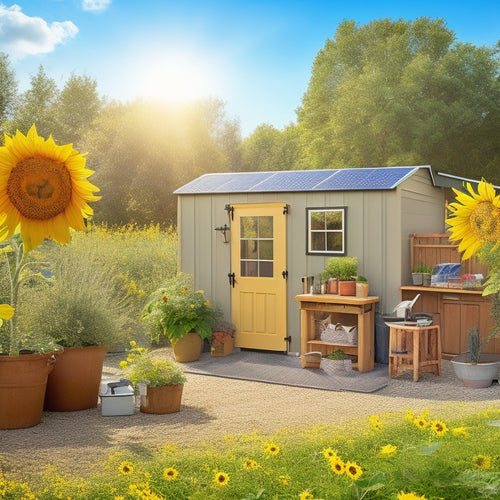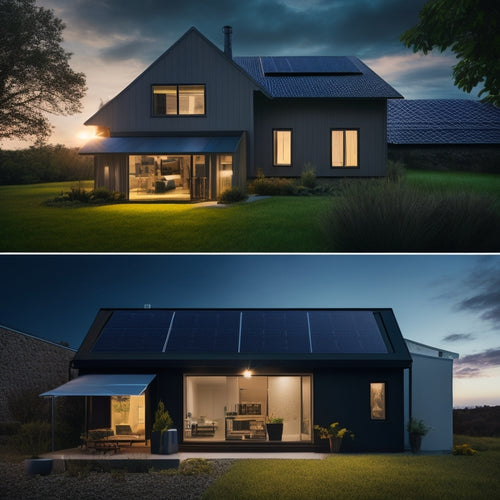
Pumping Water With Home Renewable Energy
Share
You can employ home renewable energy to pump water efficiently and sustainably. With the decreasing cost of solar panels, you can power your water pumping needs reliably. Solar water pumping systems come in two types: submersible pumps for deep wells and surface pumps for shallow sources. To optimize energy harvesting, consider pump size, pipe diameter, and valve configuration when designing your system. By understanding total adjustable head and pump efficiency, you can accurately calculate your energy requirements. Now, you're one step closer to minimizing your environmental impact and energy bills; and with proper installation and maintenance, you'll be well on your way to achieving energy independence.
Overview
- Solar water pumping systems provide energy independence and reduce greenhouse gas emissions by harnessing renewable energy from solar panels.
- Properly sizing a solar water pumping system requires calculating total adjustable head, pump efficiency, and energy requirements to ensure reliable water supply.
- Solar-powered pumps can be used for deep wells with submersible pumps or shallow sources with surface pumps, depending on water needs and pipe configuration.
- A well-designed system with efficient pumps, corrosion-resistant piping, and controllers can optimize energy harvesting and minimize losses.
- Regular maintenance, including cleaning solar panels and inspecting piping, ensures the system runs efficiently and sustainably over time.
Home Solar Panel Costs
The cost of home solar panels has decreased dramatically over the years, making them a more viable option for homeowners looking to employ renewable energy.
You'll be pleased to know that the average cost of solar panels has dropped by over 60% in the last decade, thanks to advancements in Next-Gen Photovoltaic Technologies that enhance solar cell efficiency and lower production costs.
This reduction in cost has made solar panel financing more accessible, allowing you to tap into the power of the sun without breaking the bank.
With energy savings of up to $500 per year, investing in home solar panels can pay for itself in the long run.
Benefits of Renewable Energy
As you shift to renewable energy, you'll access a multitude of benefits that extend far beyond just reducing your energy bills. One significant advantage is the minimal environmental impact.
Renewable energy sources like solar and wind power generate electricity without emitting greenhouse gases or pollutants, contributing to a cleaner environment and mitigating climate change. Additionally, by incorporating renewable energy, you'll appeal to environmentally conscious investors and customers, enhancing your business reputation while minimizing environmental impact grid resilience.
Moreover, you'll enjoy economic savings as you reduce your reliance on fossil fuels. Renewable energy can provide a stable and predictable energy cost, shielding you from price fluctuations and ensuring long-term economic freedom.
Solar Water Pumping Systems
With solar panels becoming increasingly cost-effective, you're now ready to capture the sun's energy to power your water pumping needs.
Solar water pumping systems are a reliable and efficient way to pump water for your home, farm, or ranch. As renewable future becomes a priority, solar-powered pumps can greatly reduce greenhouse gas emissions and provide energy independence.
There are two main solar pump types: submersible pumps and surface pumps. Submersible pumps are suitable for deep wells, while surface pumps are ideal for shallow wells or surface water sources.
To maximize system efficiency, it's crucial to take into account factors like pump size, pipe diameter, and valve configuration. A well-designed system will guarantee peak energy harvesting and minimize energy losses.
Calculating Energy Requirements
Determining your energy requirements is critical to sizing your solar water pumping system correctly.
To calculate your energy needs, you'll need to take into account the total adjustable head (TDH) of your system, which is the sum of the vertical lift, friction losses, and pressure required to push water through your pipes.
You'll also need to factor in the pump efficiency, which is typically between 20-40%.
Once you have these values, you can estimate your energy consumption using the following formula: energy consumption (Wh) = TDH (m) x flow rate (L/min) x specific gravity of water / pump efficiency.
Accurately calculating your energy requirements will guarantee you install a system that meets your needs and provides the freedom to pump water reliably and sustainably.
Installation and Maintenance Tips
Having calculated your energy requirements, you're now ready to install your solar water pumping system. A well-designed system guarantees efficient energy harvesting and reliable water supply. Consider factors like system design, pump selection, and piping layout to optimize performance.
| Component | Consideration | Impact |
|---|---|---|
| Pump | Select a pump that matches your energy requirements and water flow needs | Efficient energy use, reliable water supply |
| Piping | Choose piping material that resists corrosion and minimizes friction loss | Reduced energy consumption, longer system lifespan |
| Controller | Install a controller that regulates pump speed and monitors system performance | Optimized energy use, real-time system monitoring |
Regular maintenance is essential to extend the system's lifespan. Schedule periodic checks to clean the solar panels, inspect piping, and replace worn-out components.
Frequently Asked Questions
Can I Use a Wind Turbine to Power My Water Pump?
You can utilize wind energy to power your water pump, but consider the wind turbine's efficiency and your pump's compatibility; verify the turbine's output matches the pump's power requirements to optimize performance and achieve energy independence.
How Long Do Solar Water Pumps Typically Last?
Coincidentally, you're wondering about solar water pumps' lifespan, just as you're considering utilizing the sun's power. Typically, you can expect a solar pump to last around 15-20 years, depending on maintenance factors like cleaning, water quality, and component replacements.
Are Solar Water Pumps Suitable for Large-Scale Agriculture?
You'll find that solar water pumps can be suitable for large-scale agriculture, provided you consider the agricultural water needs and optimize solar pump efficiency, ensuring a reliable and sustainable water supply for your crops.
Can I Use a Battery Backup System for Water Pumping?
As you traverse the world of self-sufficiency, you're wise to take into account a battery backup system for water pumping, where a larger battery capacity and optimized pump efficiency are vital to guarantee a steady flow, even when the sun doesn't shine.
Are There Any Government Incentives for Renewable Water Pumping?
You're likely eligible for government subsidies and renewable grants, which can considerably offset the cost of your renewable water pumping system; investigate federal and state programs to examine available incentives and tax credits that can benefit you.
Ready to Buy
As you utilize the power of home renewable energy to pump water, remember that every watt counts. With solar water pumping systems, you're not only reducing your carbon footprint but also tapping into a sustainable future. The numbers add up: lower energy bills, increased energy independence, and a quieter, more reliable water supply. So, seize the day – and the sun's energy – to quench your thirst for a greener tomorrow.
Related Posts
-

Building an Emergency Backup Solar Power System in 5 Essential Steps
Building an emergency backup solar power system involves five key steps. First, assess your daily energy needs to ide...
-

Top Portable Refrigerators for Camping Adventures
When you're camping, having a reliable portable refrigerator can make all the difference for keeping your food fresh ...
-

Cost of Home Solar Battery
You're looking to invest in a home solar battery to reduce your grid reliance, but you're curious about the cost. The...


